Saturday, 11 October: Dancing in the streets
The breakfast buffet. I've seen some elaborate ones, but this one takes the cake. First, it's served in the panoramic revolving restaurant on the hotel's 25th floor, so the view is amazing and ever changing (so is the location of your table—you have to note its row number because, when you come back from a trip to the buffet, which is on the nonmoving central core, you'll have to find it again; it won't be in the same place). Second, it's included in the price of the room! For photos and the full description, see The breakfast buffet on the next page.
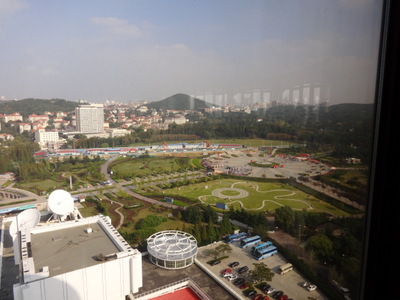
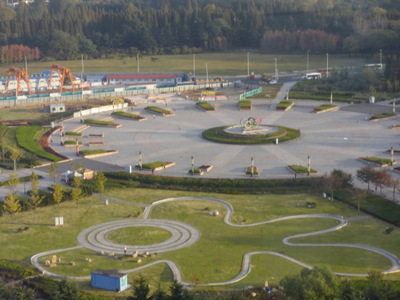 Saturday morning, while we ate our breakfast, we rotated past the vast round paved area near the sports stadium (I was right; it is the top of a huge underground parking structure; note that the parking occupies not just the space under the paved circle but all that under the surrounding parkland as well). At the left is the view as it actually looked from the 25th floor that day; on the right is a telephoto shot taken later in the week, when the place was empty. The construction zone behind it is the first line of the incipient Qingdao Metro, which will open in February 2015 (or so; it was supposed to open this year, but the excavations ran into harder stone than expected). The high-rise building beyond that is the Huant Hai Hotel, where the conference actually took place. In the center of the area was a giant multi-colored set of the five olympic rings (because Qingdao was the site of the sailing competitions for the Beijing Olympics), and around them, on Saturday morning, scattered all over the circle, groups of people in brightly colored costumes were dancing! Okay, gotta check that out.
Saturday morning, while we ate our breakfast, we rotated past the vast round paved area near the sports stadium (I was right; it is the top of a huge underground parking structure; note that the parking occupies not just the space under the paved circle but all that under the surrounding parkland as well). At the left is the view as it actually looked from the 25th floor that day; on the right is a telephoto shot taken later in the week, when the place was empty. The construction zone behind it is the first line of the incipient Qingdao Metro, which will open in February 2015 (or so; it was supposed to open this year, but the excavations ran into harder stone than expected). The high-rise building beyond that is the Huant Hai Hotel, where the conference actually took place. In the center of the area was a giant multi-colored set of the five olympic rings (because Qingdao was the site of the sailing competitions for the Beijing Olympics), and around them, on Saturday morning, scattered all over the circle, groups of people in brightly colored costumes were dancing! Okay, gotta check that out.
After breakfast, we strolled over and found that a competition was going on. On two stages on opposite sides of the circle, groups of 6 to 12 young people in matching sequined costumes, aged from about 5 to about 18 (plus one group of middle-aged ladies), were performing routines sort of like those the FSU Golden Girls do at football games. All the signage was in Chinese, but the url "www.qmjscw.com" was prominently displayed. The site's entirely in Chinese, so when I checked it later, I couldn't make much of it (can any readers out there enlighten me?), but it's apparently a big, national deal (although a local Chinese grad student I spoke with had never heard of it). For photos and description, see QMJSCW on the next page.
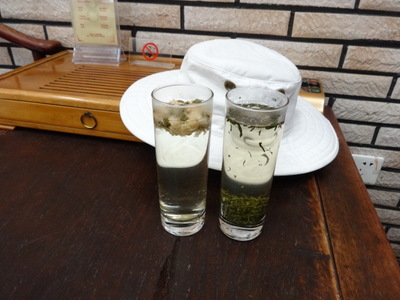
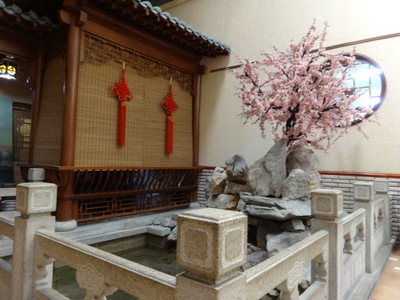
After watching the dancers until our feet couldn't take standing around on concrete anymore, we walked on up the hill to the meeting venue, at the Huang Hai Hotel, to check it out. Of the three hotels recommended on the meeting website, this was the one that had no English whatsoever on its website, so I hadn't been able to check out its restaurant menus, amenities, or whatever in advance. True to form, all its signage (mostly electronic LCD) was Chinese only. It was early for lunch, so we settled in its attractive little tea room, where fortunately, the dozen or so teas on the menu were translated. David ordered a cup of green tea and I ordered one of chrysanthemum tea (the two least elaborate and expensive alternatives). Both were served ferociously hot in tall glass tumblers. Since we were just killing time anyway, we were happy to wait while it cooled, admiring the lovely (though artificial) flowering cherry tree hanging over the (real) goldfish pool next to our table. I was curious to see whether the chrysanthemum tea consisted of chrysanthemum leaves or flowers or was merely flavored with them. It turned out to consist entirely of whole dried white chrysanthemum flowers, which formed a dense mat on the top surface of the tea and gradually plumped back up to look like flowers. Both teas were delicious, and the chrysanthemums didn't seem to aggravate my hay fever, as I'm told chamomile can.
We then moved on to one of the hotel's two restaurants, the less formal in our opinion, based solely on visual impression. Instead of being handed menus, we were conducted to a long wall, not visible from the entrance we had peeked in through, arrayed floor to ceiling with foodstuffs. The waitress stood by with pencil and order pad and indicated that we should make our choice. Yikes.
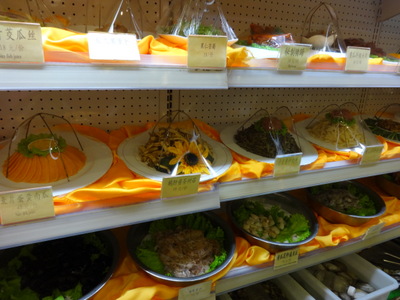
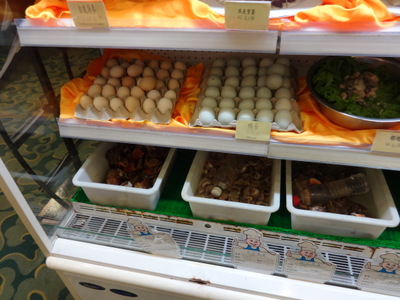 The bottom row was a series of bins full of live mollusks (little gastropods and ones the size of my fist, at least six different sizes and shapes of bivalves); a big bowl of shucked raw oysters; then open trays of crabs; freshly dead fishes of several species; and one large, disembodied fish head. Parts of that row are visible at the bottoms of both photos. Above them were rows of different meats (some real and some artificial for display only) and many kinds of prepared foods; some but not all were briefly labeled in English (for example, in the left-hand photo, the orange dish at the left is labeled "Nice fish juice," second from the right on the top row is "Pig hand" (pigs' trotters, I'm pretty sure), and the second from the right just above the bivalves is "cucumber flower fried scallop"; the rest are untranslated). Also chicken and duck eggs, noodles of different kinds. Across the top were whole raw vegetables.
The bottom row was a series of bins full of live mollusks (little gastropods and ones the size of my fist, at least six different sizes and shapes of bivalves); a big bowl of shucked raw oysters; then open trays of crabs; freshly dead fishes of several species; and one large, disembodied fish head. Parts of that row are visible at the bottoms of both photos. Above them were rows of different meats (some real and some artificial for display only) and many kinds of prepared foods; some but not all were briefly labeled in English (for example, in the left-hand photo, the orange dish at the left is labeled "Nice fish juice," second from the right on the top row is "Pig hand" (pigs' trotters, I'm pretty sure), and the second from the right just above the bivalves is "cucumber flower fried scallop"; the rest are untranslated). Also chicken and duck eggs, noodles of different kinds. Across the top were whole raw vegetables.
We were somewhat stunned at the choices and didn't have with us our page from the guidebook that provided phrases telling how we wanted things prepared—deep fried, stewed, stir-fried with garlic and chilis, etc. We also had no idea of the appropriate preparation for many of the foods—would those little gastropods be hopelessly chewy unless stewed? I wished I knew how to say "whatever the chef recommends, so long as it's cooked and not raw."
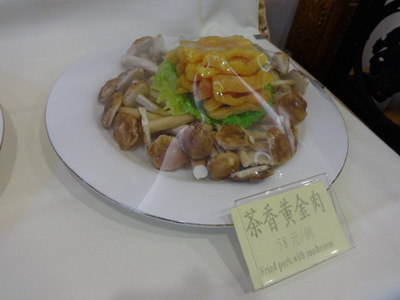
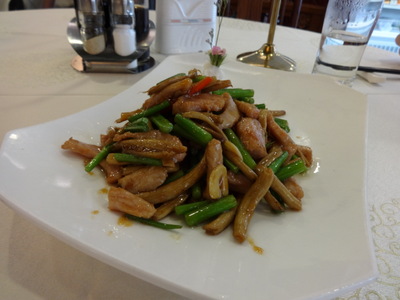 On an adjacent wall was a selection of set dishes; the raw ingredients for each were arrayed on a plate and covered tightly with plastic wrap. We chose "fried pork with mushrooms" from there, which turned out to be pretty good— pork strips with skinny celery sticks and mushrooms in a sauce. At the left is the display version in the raw state, and at the right the finished dish as it came to the table. I think the mushrooms were Agrocybe aegerita, (called yanagi matsutake in Japanese) or maybe Flammulina velutipes.
On an adjacent wall was a selection of set dishes; the raw ingredients for each were arrayed on a plate and covered tightly with plastic wrap. We chose "fried pork with mushrooms" from there, which turned out to be pretty good— pork strips with skinny celery sticks and mushrooms in a sauce. At the left is the display version in the raw state, and at the right the finished dish as it came to the table. I think the mushrooms were Agrocybe aegerita, (called yanagi matsutake in Japanese) or maybe Flammulina velutipes.
They seemed to be the most common kind we encountered on the trip.
We didn't understand when asked whether we wanted rice and wound up not getting any, but the pork was good anyway. We were served hot water with it, apparently quite a common table drink here (several people on the flight over asked for and received it without a batted eye). We were fine with hot (i.e., recently boiled) water, since we don't trust the cold stuff straight from the tap.
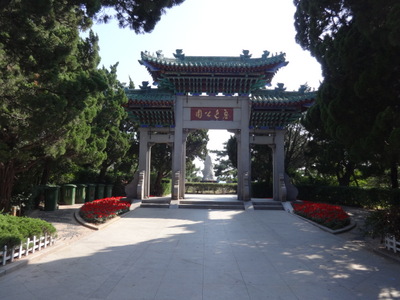
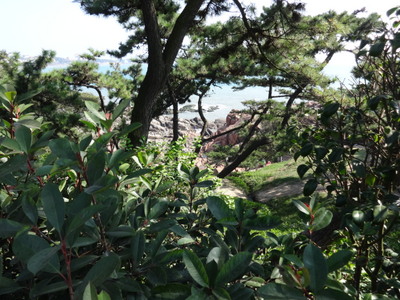 From there, we walked toward the old town, with the vague destination of the old German concession and the German Governor's Residence (now a museum). We didn't make it before our feet gave out, so we just turned around and walked back. Our route took us along the coast past Lu Xun Park (named for a famous writer; the park's gate on the left and a view down through the trees to the water's edge on the right), which occupies a wonderfully scenic stretch of rocky shoreline, as well as along several streets lined with shops and small restaurants. Many displayed their names in English, or at least in transliteration, as well as Chinese—I recognized the word "bao" in the name of an open-fronted shop where a guy was steaming round trays of stuffed buns. My favorite business was "Qingdao Happy Slow Delivery"; we learned later, from our Thursday tour guide, that the common Chinese parting phrase is "go slowly," meaning "fare well" or "take care," so I suspect they really meant "careful delivery."
From there, we walked toward the old town, with the vague destination of the old German concession and the German Governor's Residence (now a museum). We didn't make it before our feet gave out, so we just turned around and walked back. Our route took us along the coast past Lu Xun Park (named for a famous writer; the park's gate on the left and a view down through the trees to the water's edge on the right), which occupies a wonderfully scenic stretch of rocky shoreline, as well as along several streets lined with shops and small restaurants. Many displayed their names in English, or at least in transliteration, as well as Chinese—I recognized the word "bao" in the name of an open-fronted shop where a guy was steaming round trays of stuffed buns. My favorite business was "Qingdao Happy Slow Delivery"; we learned later, from our Thursday tour guide, that the common Chinese parting phrase is "go slowly," meaning "fare well" or "take care," so I suspect they really meant "careful delivery."
Twice, in front of shops, we encountered a disheveled and despondent kitten in a cage on the sidewalk, provided with a dish of water and a dish of noodles. Heaven protect all cats who depend for their food on people who don't realize they're obligate carnivores!
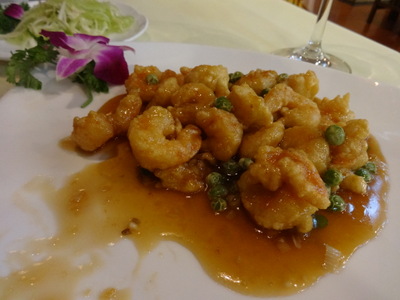
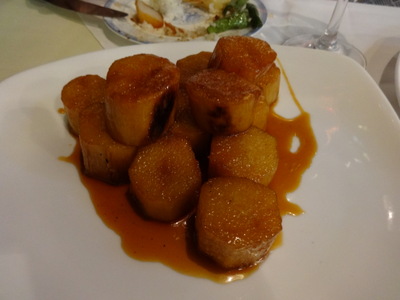 Back at the hotel, after we'd rested our feet and David had practiced his talk, we went downstairs to have dinner at the Qingdao Specialties restaurant. I was delighted to encounter a hugely elaborate array of aquaria teeming with edible sea life—all the kinds we'd seen at the other hotel plus dozens more, including abalone, sipunculids (looking like badly made wieners), mantis shrimp, and large red starfish. From the menu on line, I had actually already picked out a dish I wanted to try—a whole fish, with the flesh scored into squares, split along the stomach to life flat, deep fried, and served with sweet and sour sauce. At the table, they brought us the English menu (they only have one), a large, colorful photo album with bilingual labels, which turned out to be way more extensive than the website had implied. By page 2, my deep-fried fish had already been eclipsed by the possibility of a roasted eel in a shiny mahogany-colored glaze. Unfortunately, fatigue, jet lag, and his usual aversion to dead fish had caught up with David, and he put his foot down—he couldn't cope with having either of my choices on the table. We wound up with stir-fried beef with lilies (both dried tiger-lily buds and wonderfully sweet and tender "petals" of tiny onions), deep-fried prawns and green peas with sweet and sour sauce (left), and quick-fried yams in syrup. Those last turned out to be cylinders of real yam, not sweet potatoes, but were quite reminiscent of the sweet potatoes Americans eat as "candied yams" at Thanksgiving time. David felt much better when he saw the wine list; they had all the greats (at concommitantly exorbitant prices). He ordered a bottle of a lesser red labeled (I think) "Zhangyu," actually made locally, and was very happy with it, saying he could have believed it was a Côtes du Rhône.
Back at the hotel, after we'd rested our feet and David had practiced his talk, we went downstairs to have dinner at the Qingdao Specialties restaurant. I was delighted to encounter a hugely elaborate array of aquaria teeming with edible sea life—all the kinds we'd seen at the other hotel plus dozens more, including abalone, sipunculids (looking like badly made wieners), mantis shrimp, and large red starfish. From the menu on line, I had actually already picked out a dish I wanted to try—a whole fish, with the flesh scored into squares, split along the stomach to life flat, deep fried, and served with sweet and sour sauce. At the table, they brought us the English menu (they only have one), a large, colorful photo album with bilingual labels, which turned out to be way more extensive than the website had implied. By page 2, my deep-fried fish had already been eclipsed by the possibility of a roasted eel in a shiny mahogany-colored glaze. Unfortunately, fatigue, jet lag, and his usual aversion to dead fish had caught up with David, and he put his foot down—he couldn't cope with having either of my choices on the table. We wound up with stir-fried beef with lilies (both dried tiger-lily buds and wonderfully sweet and tender "petals" of tiny onions), deep-fried prawns and green peas with sweet and sour sauce (left), and quick-fried yams in syrup. Those last turned out to be cylinders of real yam, not sweet potatoes, but were quite reminiscent of the sweet potatoes Americans eat as "candied yams" at Thanksgiving time. David felt much better when he saw the wine list; they had all the greats (at concommitantly exorbitant prices). He ordered a bottle of a lesser red labeled (I think) "Zhangyu," actually made locally, and was very happy with it, saying he could have believed it was a Côtes du Rhône.
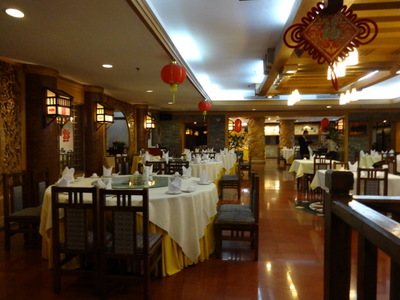
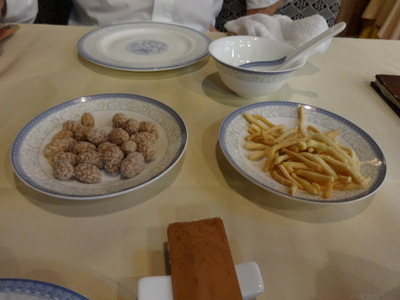 Here's the view of the restaurant interior (left) and the amuse-bouche we were served every time we went there (right). The dish on the left is filled with sugared peanuts and that on the right with what seemed to be ordinary crisp chow mein noodles.
Here's the view of the restaurant interior (left) and the amuse-bouche we were served every time we went there (right). The dish on the left is filled with sugared peanuts and that on the right with what seemed to be ordinary crisp chow mein noodles.
With the meal, we were each served a little glass bowl of tea and a glass of hot water. We were puzzled by the tea at first, wondering if it was a dipping sauce or some such, but I surreptitiously tasted it with my otherwise unused porcelain spoon and identified it before we embarassed ourselves by, e.g., pouring it over our rice. Rice, interestingly enough, seems to be in short supply. It doesn't come automatically with anything, and the wait staff seem almost reluctant to serve it.
Also interestingly, when David asked for wine, the waiter (who turned out to be the wine guy as well; I think he was taking our order because his English was the best, although not terrific) replied "vin"? in the French pronunciation. He decanted it, so I didn't get to read the label, and I didn't put the pronunciation
thing together in time to ask if he spoke French. It's entirely possible that he'd learned his wines from a French speaker, either in China or in France! A wine David ordered later, at another restaurant was labeled entirely in English and Chinese except for the word "rouge," front and center on the label.
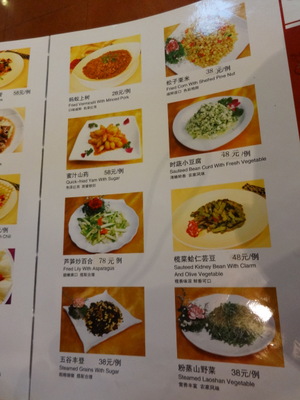
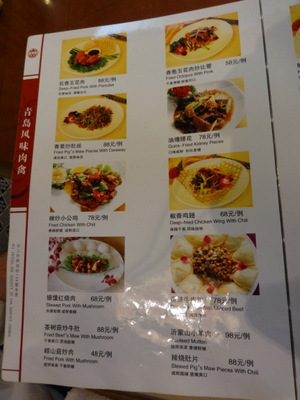 Here are a few pages from the pictorial menu. The page at the left offers "Fried vermicelli with minced pork," "Quick-fried yam with sugar" (which we ordered twice), "Fried lily with asparagus," "Steamed grains with sugar," "Fried corn with shelled pine nut," "Sauteed bean curd with fresh vegetable," "Sauteed kidney bean with clam and olive vegetable," and "Steamed Laoshan vegetable" (Laoshan is the name of Qingdao's province).
Here are a few pages from the pictorial menu. The page at the left offers "Fried vermicelli with minced pork," "Quick-fried yam with sugar" (which we ordered twice), "Fried lily with asparagus," "Steamed grains with sugar," "Fried corn with shelled pine nut," "Sauteed bean curd with fresh vegetable," "Sauteed kidney bean with clam and olive vegetable," and "Steamed Laoshan vegetable" (Laoshan is the name of Qingdao's province).
The one at the right lists "Fried pig's maw pieces with caraway," "Fried chicken with chili," "Stewed pork with mushroom," "Fried octopus with pork," "Quick fried kidney pieces," Deep-fried chicken wing with chili," and "Deep-fried pie with minced beef." Then, across the bottom, without pictures, "Fried beef's maw with mushroom," "Fried pork with mushroom," "Sauteed mutton," and "Stewed pig's maw pieces with chili."
Other pages of main courses include a number of shark-fin dishes, including shark fin with stewed crane, as well as many variations on sea cucumber, fried pork chop, deep-fried pigeon, and abalone (the Wednesday special was "Abalone stewed with chicken paws").
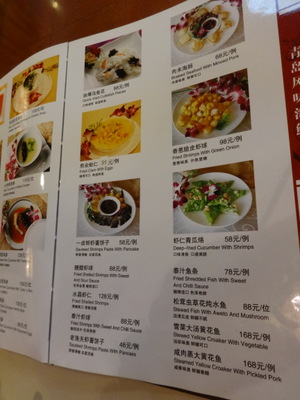
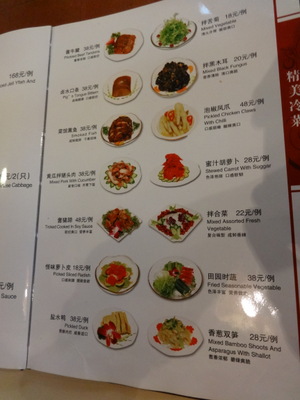 The page at the left here shows "Quick-fried cuttlefish pieces," "Fried clam with eggs," "Sauteed shrimps paste with pancake," "Braised seafood with minced pork," "Fried shrimps with green onion" (we had this once but didn't repeat it; it was good, but it had no sauce), and "Deep-fried cucumber with shrimps."
The page at the left here shows "Quick-fried cuttlefish pieces," "Fried clam with eggs," "Sauteed shrimps paste with pancake," "Braised seafood with minced pork," "Fried shrimps with green onion" (we had this once but didn't repeat it; it was good, but it had no sauce), and "Deep-fried cucumber with shrimps."
Below, without illustrations, it lists "Fried shelled shrimps with sweet and sour sauce" (which we odered twice), "Fried shelled shrimps," "Fried shrimps with sweet and chilli sauce," "Sauteed shrimps paste with pancaes" (presumably "with pancakes"), "Fried shredded fish with sweet and chilli sauce," "stewed fish with aweto and mushroom" ("aweto" is an insect larva several inches infected with a fungal parasite that grows a several-inch fruiting body out of the larva's head; the fungus kills the subterranean larva, then grows its fruiting stalk up out of the soil into the air; as one rather biologically naive website puts it, "the aweto is a worm in winter but a kind of grass in summer"), "Stewed yellow croaker with vegetable," and "steamed yellow croaker with pickled pork."
The page at the right shows "Pig's tongue bittern" (don't know what a bittern had to do with it . . .), "Smoked fish," "Minced pork with cucumber," "Trcked cooked in soy sauce" (we never did parse that one; turkey?), "Pickled sliced radish," "Pickled duck," "Mixed vegetable," "Mixed black fungus" (cloud ear, I think), "Picled chicken claws with chilli," "Stewed carrot with suggar," "Mixed assorted fresh vegetable," "Fried seasonable vegtable," and "Mixed bamboo shoots and asparagus with shallot" (we ordered that one, and it was very good—all the vegetables were finely shredded, lightly cooked, and served cold as a sort of crispy salad).
The menu was probably 30 pages long. I wish I'd been able to photograph all the pages!
previous entry
List of Entries
next entry

 Saturday morning, while we ate our breakfast, we rotated past the vast round paved area near the sports stadium (I was right; it is the top of a huge underground parking structure; note that the parking occupies not just the space under the paved circle but all that under the surrounding parkland as well). At the left is the view as it actually looked from the 25th floor that day; on the right is a telephoto shot taken later in the week, when the place was empty. The construction zone behind it is the first line of the incipient Qingdao Metro, which will open in February 2015 (or so; it was supposed to open this year, but the excavations ran into harder stone than expected). The high-rise building beyond that is the Huant Hai Hotel, where the conference actually took place. In the center of the area was a giant multi-colored set of the five olympic rings (because Qingdao was the site of the sailing competitions for the Beijing Olympics), and around them, on Saturday morning, scattered all over the circle, groups of people in brightly colored costumes were dancing! Okay, gotta check that out.
Saturday morning, while we ate our breakfast, we rotated past the vast round paved area near the sports stadium (I was right; it is the top of a huge underground parking structure; note that the parking occupies not just the space under the paved circle but all that under the surrounding parkland as well). At the left is the view as it actually looked from the 25th floor that day; on the right is a telephoto shot taken later in the week, when the place was empty. The construction zone behind it is the first line of the incipient Qingdao Metro, which will open in February 2015 (or so; it was supposed to open this year, but the excavations ran into harder stone than expected). The high-rise building beyond that is the Huant Hai Hotel, where the conference actually took place. In the center of the area was a giant multi-colored set of the five olympic rings (because Qingdao was the site of the sailing competitions for the Beijing Olympics), and around them, on Saturday morning, scattered all over the circle, groups of people in brightly colored costumes were dancing! Okay, gotta check that out. 


 The bottom row was a series of bins full of live mollusks (little gastropods and ones the size of my fist, at least six different sizes and shapes of bivalves); a big bowl of shucked raw oysters; then open trays of crabs; freshly dead fishes of several species; and one large, disembodied fish head. Parts of that row are visible at the bottoms of both photos. Above them were rows of different meats (some real and some artificial for display only) and many kinds of prepared foods; some but not all were briefly labeled in English (for example, in the left-hand photo, the orange dish at the left is labeled "Nice fish juice," second from the right on the top row is "Pig hand" (pigs' trotters, I'm pretty sure), and the second from the right just above the bivalves is "cucumber flower fried scallop"; the rest are untranslated). Also chicken and duck eggs, noodles of different kinds. Across the top were whole raw vegetables.
The bottom row was a series of bins full of live mollusks (little gastropods and ones the size of my fist, at least six different sizes and shapes of bivalves); a big bowl of shucked raw oysters; then open trays of crabs; freshly dead fishes of several species; and one large, disembodied fish head. Parts of that row are visible at the bottoms of both photos. Above them were rows of different meats (some real and some artificial for display only) and many kinds of prepared foods; some but not all were briefly labeled in English (for example, in the left-hand photo, the orange dish at the left is labeled "Nice fish juice," second from the right on the top row is "Pig hand" (pigs' trotters, I'm pretty sure), and the second from the right just above the bivalves is "cucumber flower fried scallop"; the rest are untranslated). Also chicken and duck eggs, noodles of different kinds. Across the top were whole raw vegetables.
 On an adjacent wall was a selection of set dishes; the raw ingredients for each were arrayed on a plate and covered tightly with plastic wrap. We chose "fried pork with mushrooms" from there, which turned out to be pretty good— pork strips with skinny celery sticks and mushrooms in a sauce. At the left is the display version in the raw state, and at the right the finished dish as it came to the table. I think the mushrooms were Agrocybe aegerita, (called yanagi matsutake in Japanese) or maybe Flammulina velutipes.
On an adjacent wall was a selection of set dishes; the raw ingredients for each were arrayed on a plate and covered tightly with plastic wrap. We chose "fried pork with mushrooms" from there, which turned out to be pretty good— pork strips with skinny celery sticks and mushrooms in a sauce. At the left is the display version in the raw state, and at the right the finished dish as it came to the table. I think the mushrooms were Agrocybe aegerita, (called yanagi matsutake in Japanese) or maybe Flammulina velutipes.
 From there, we walked toward the old town, with the vague destination of the old German concession and the German Governor's Residence (now a museum). We didn't make it before our feet gave out, so we just turned around and walked back. Our route took us along the coast past Lu Xun Park (named for a famous writer; the park's gate on the left and a view down through the trees to the water's edge on the right), which occupies a wonderfully scenic stretch of rocky shoreline, as well as along several streets lined with shops and small restaurants. Many displayed their names in English, or at least in transliteration, as well as Chinese—I recognized the word "bao" in the name of an open-fronted shop where a guy was steaming round trays of stuffed buns. My favorite business was "Qingdao Happy Slow Delivery"; we learned later, from our Thursday tour guide, that the common Chinese parting phrase is "go slowly," meaning "fare well" or "take care," so I suspect they really meant "careful delivery."
From there, we walked toward the old town, with the vague destination of the old German concession and the German Governor's Residence (now a museum). We didn't make it before our feet gave out, so we just turned around and walked back. Our route took us along the coast past Lu Xun Park (named for a famous writer; the park's gate on the left and a view down through the trees to the water's edge on the right), which occupies a wonderfully scenic stretch of rocky shoreline, as well as along several streets lined with shops and small restaurants. Many displayed their names in English, or at least in transliteration, as well as Chinese—I recognized the word "bao" in the name of an open-fronted shop where a guy was steaming round trays of stuffed buns. My favorite business was "Qingdao Happy Slow Delivery"; we learned later, from our Thursday tour guide, that the common Chinese parting phrase is "go slowly," meaning "fare well" or "take care," so I suspect they really meant "careful delivery." 
 Back at the hotel, after we'd rested our feet and David had practiced his talk, we went downstairs to have dinner at the Qingdao Specialties restaurant. I was delighted to encounter a hugely elaborate array of aquaria teeming with edible sea life—all the kinds we'd seen at the other hotel plus dozens more, including abalone, sipunculids (looking like badly made wieners), mantis shrimp, and large red starfish. From the menu on line, I had actually already picked out a dish I wanted to try—a whole fish, with the flesh scored into squares, split along the stomach to life flat, deep fried, and served with sweet and sour sauce. At the table, they brought us the English menu (they only have one), a large, colorful photo album with bilingual labels, which turned out to be way more extensive than the website had implied. By page 2, my deep-fried fish had already been eclipsed by the possibility of a roasted eel in a shiny mahogany-colored glaze. Unfortunately, fatigue, jet lag, and his usual aversion to dead fish had caught up with David, and he put his foot down—he couldn't cope with having either of my choices on the table. We wound up with stir-fried beef with lilies (both dried tiger-lily buds and wonderfully sweet and tender "petals" of tiny onions), deep-fried prawns and green peas with sweet and sour sauce (left), and quick-fried yams in syrup. Those last turned out to be cylinders of real yam, not sweet potatoes, but were quite reminiscent of the sweet potatoes Americans eat as "candied yams" at Thanksgiving time. David felt much better when he saw the wine list; they had all the greats (at concommitantly exorbitant prices). He ordered a bottle of a lesser red labeled (I think) "Zhangyu," actually made locally, and was very happy with it, saying he could have believed it was a Côtes du Rhône.
Back at the hotel, after we'd rested our feet and David had practiced his talk, we went downstairs to have dinner at the Qingdao Specialties restaurant. I was delighted to encounter a hugely elaborate array of aquaria teeming with edible sea life—all the kinds we'd seen at the other hotel plus dozens more, including abalone, sipunculids (looking like badly made wieners), mantis shrimp, and large red starfish. From the menu on line, I had actually already picked out a dish I wanted to try—a whole fish, with the flesh scored into squares, split along the stomach to life flat, deep fried, and served with sweet and sour sauce. At the table, they brought us the English menu (they only have one), a large, colorful photo album with bilingual labels, which turned out to be way more extensive than the website had implied. By page 2, my deep-fried fish had already been eclipsed by the possibility of a roasted eel in a shiny mahogany-colored glaze. Unfortunately, fatigue, jet lag, and his usual aversion to dead fish had caught up with David, and he put his foot down—he couldn't cope with having either of my choices on the table. We wound up with stir-fried beef with lilies (both dried tiger-lily buds and wonderfully sweet and tender "petals" of tiny onions), deep-fried prawns and green peas with sweet and sour sauce (left), and quick-fried yams in syrup. Those last turned out to be cylinders of real yam, not sweet potatoes, but were quite reminiscent of the sweet potatoes Americans eat as "candied yams" at Thanksgiving time. David felt much better when he saw the wine list; they had all the greats (at concommitantly exorbitant prices). He ordered a bottle of a lesser red labeled (I think) "Zhangyu," actually made locally, and was very happy with it, saying he could have believed it was a Côtes du Rhône. 
 Here's the view of the restaurant interior (left) and the amuse-bouche we were served every time we went there (right). The dish on the left is filled with sugared peanuts and that on the right with what seemed to be ordinary crisp chow mein noodles.
Here's the view of the restaurant interior (left) and the amuse-bouche we were served every time we went there (right). The dish on the left is filled with sugared peanuts and that on the right with what seemed to be ordinary crisp chow mein noodles.
 Here are a few pages from the pictorial menu. The page at the left offers "Fried vermicelli with minced pork," "Quick-fried yam with sugar" (which we ordered twice), "Fried lily with asparagus," "Steamed grains with sugar," "Fried corn with shelled pine nut," "Sauteed bean curd with fresh vegetable," "Sauteed kidney bean with clam and olive vegetable," and "Steamed Laoshan vegetable" (Laoshan is the name of Qingdao's province).
Here are a few pages from the pictorial menu. The page at the left offers "Fried vermicelli with minced pork," "Quick-fried yam with sugar" (which we ordered twice), "Fried lily with asparagus," "Steamed grains with sugar," "Fried corn with shelled pine nut," "Sauteed bean curd with fresh vegetable," "Sauteed kidney bean with clam and olive vegetable," and "Steamed Laoshan vegetable" (Laoshan is the name of Qingdao's province).
 The page at the left here shows "Quick-fried cuttlefish pieces," "Fried clam with eggs," "Sauteed shrimps paste with pancake," "Braised seafood with minced pork," "Fried shrimps with green onion" (we had this once but didn't repeat it; it was good, but it had no sauce), and "Deep-fried cucumber with shrimps."
The page at the left here shows "Quick-fried cuttlefish pieces," "Fried clam with eggs," "Sauteed shrimps paste with pancake," "Braised seafood with minced pork," "Fried shrimps with green onion" (we had this once but didn't repeat it; it was good, but it had no sauce), and "Deep-fried cucumber with shrimps."